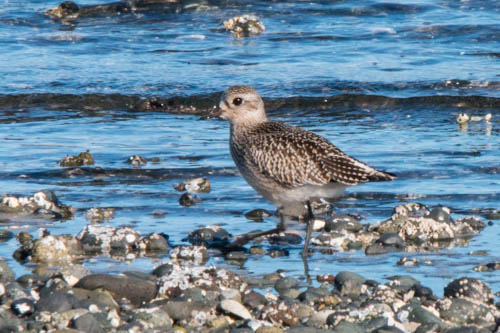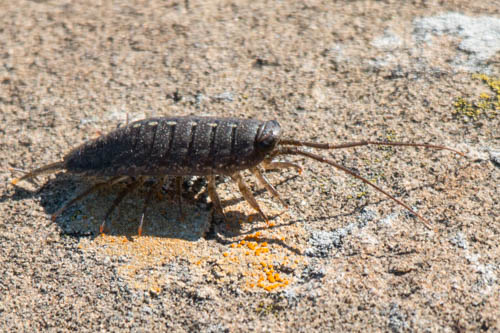Dennis Forsyth writes: I found a small flock of Black-bellied Plovers near the Lindsay-Dickson Nature Reserve beach today apparently feasting on these tasty looking critters. The arthropods were a little more than an inch long and there were hordes of them skittering in and out of the tidal pools along that stretch of beach. Perhaps Mike might venture an ID. Dennis
Note: Black-bellied Plovers are on our shores year-round except for the May, June and July breeding season.
Hi Dennis—
Your arthropods are Isopods, a group that includes the land-living Sow Bugs and Pill Bugs. I think this is the species known as Sea Slater (probably Ligia pallasi), which lives in the high intertidal. Although evolutionarily they are of marine origin, Ligia breathes air, avoids water and can drown. They hide in rock crevices and eat dead algae. The one in your photo looks like an immature; adults are more flattened and can reach 3.5cm in length.
Nice observation of BB Plovers eating them.
Mike
Dennis replies: OK, my fumbling attempts at ID-ing via the internet led me to believe that they were Ligia so I’m glad to have that confirmed. I’m a bit puzzled by the ‘avoids water and can drown’ bit. I did see several of the little scuttlers enter shallow, small diameter tidal pools and move rapidly within them. Many of them simply transited the pool and re-emerged on the other side. I didn’t observe diligently enough to know whether any of them actually found refuge down there and remained. Mostly they seemed to be seeking shelter under things on the surface.
Of course my approach with typical humanoid stomping and clomping was very likely much more alarming to them than the light-footed Plovers would have been. Dennis



